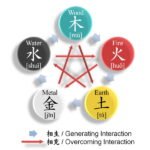Introduction to the Later Three Kingdoms Era
The Later Three Kingdoms Era marks a pivotal transition in Korean history, occurring in the late 9th to early 10th centuries after the disintegration of the Unified Silla. This period is characterized by the fragmentation of political power among three significant kingdoms: Later Baekje, Silla, and Goguryeo. The dissolution of the Unified Silla, which had fostered relative stability and prosperity, was driven by a combination of internal strife, regional uprisings, and external pressures from emerging powers. The decline of central authority led to a power vacuum that various military leaders and local aristocrats sought to exploit.
During this turbulent time, the political landscape of the Korean Peninsula was fraught with competition and conflict. The emergence of Later Baekje, founded by Gyeon Hwon, represented a revival of Baekje’s cultural and political influence in the region. It sought to reclaim territory and power that had been lost to Silla and its rivals, as well as to establish itself as a significant player in the dynamic maneuverings of the era. Concurrently, Silla experienced its own challenges, as local leaders gained autonomy, resulting in a fragmentation that weakened the state’s cohesiveness.
Meanwhile, the northern kingdom of Goguryeo sought to reassert its historical dominance, capitalizing on the political chaos surrounding it. As former territories of Goguryeo were reconfigured and leaders with ambitions arose, this era was marked by intense military confrontations and shifting alliances. The competition for supremacy among the three states led to various diplomatic strategies aimed at consolidating power and resources, while also fostering a rich cultural exchange, laying the groundwork for the birth of the Goryeo Dynasty. This dynamic environment fostered not just conflict but also innovation in governance, military strategy, and cultural identity.
Political Turmoil and Fragmentation
The Later Three Kingdoms Era, characterized by a precarious balance of power among the kingdoms of Goguryeo, Baekje, and Silla, witnessed escalating political turmoil and fragmentation that significantly influenced Korean history. Internal strife emerged as a predominant factor, with power struggles among the ruling elite contributing to an environment of instability. Each kingdom experienced its share of factional disputes, often leading to ineffective governance and civil unrest. The inability of the leaders to maintain a cohesive political structure exacerbated these issues, fostering an environment ripe for dissent.
In addition to internal discord, external threats played a crucial role in shaping the political landscape of this era. The rise of neighboring powers, such as the Tang Dynasty in China, pressured the Korean kingdoms to arm themselves defensively while simultaneously contesting for dominance. This external aggression intensified existing rivalries and made alliances precarious. The interactions with the Tang Dynasty, marked by both conflict and collaboration, further complicated the relationships among the kingdoms, creating a sense of urgency and desperation among the ruling powers to consolidate their territories and resources.
Notable figures such as King Mu of Baekje exemplified the dynamics of this turbulent period. His attempts to unify the fractured kingdom through military expeditions and diplomatic maneuvers highlighted the complexities of leadership during a time when personal ambition often overshadowed collective well-being. Similarly, the maneuvers of leaders in Silla to counter both external and internal threats showcased the constant balancing act required to maintain sovereignty amidst chaos.
The combination of these factors—internal strife, power struggles, and external pressures—culminated in a fragmented political landscape that ultimately set the stage for the emergence of the Goryeo Dynasty. This pivotal transition reflects how periods of significant discord can inadvertently catalyze profound historical transformations.
Cultural Developments in a Fragmented Korea
During the Later Three Kingdoms Era, which spanned from the late 9th to the early 10th centuries, Korea experienced a distinct cultural evolution amid political fragmentation. As the three kingdoms—Goryeo, Silla, and Baekje—vied for power and resources, this competition spurred various advancements in art, literature, and religion. The upheavals in governance created a unique environment where cultural expression flourished, allowing diverse forms of creativity to emerge.
Art during this period displayed a significant departure from previous styles, adopting innovative techniques and materials. Pottery, for instance, became highly refined, with the production of celadon reaching extraordinary levels of sophistication. Artists began to explore individual styles, leading to a blend of influences drawn from the Chinese Tang dynasty while establishing distinctly Korean characteristics. Sculpture, particularly Buddhist iconography, also evolved, with detailed representations reflecting both religious devotion and the artists’ burgeoning skill. Notably, the reverence for nature in Korean art became more pronounced, setting the stage for future movements.
Literature, influenced by this cultural milieu, saw the rise of significant works that delved into the human experience. Traditional poetry and prose began incorporating local folklore and history, fostering a rich tapestry of storytelling that resonated with the populace. During this time, the use of the Korean script (Hangul) began to take shape, although it would not be fully developed until later. This advancement in written language allowed for a broader dissemination of literature and thoughts, promoting a sense of shared identity among the people.
Buddhism, already a dominant religious force, continued to flourish during this period, profoundly impacting societal norms and values. The presence of numerous Buddhist temples played a crucial role in community life as they became centers of learning, culture, and spiritual guidance. Monks contributed to the spread of knowledge while engaging in scholarly pursuits that synthesized Buddhist philosophy with local beliefs, thereby enriching the cultural landscape of a fragmented Korea.
Rise of Goryeo: The Unifying Force
The rise of the Goryeo dynasty in the 10th century marked a significant turning point in Korean history, serving as a unifying force amidst the tumultuous period known as the Later Three Kingdoms Era. Prior to Goryeo’s emergence, the Korean Peninsula was fragmented, characterized by intense power struggles among the rival kingdoms of Silla, Baekje, and Goguryeo. This disunity created an environment ripe for conflict; however, it also provided an opportunity for a leader with vision and strategic acumen to consolidate power and establish stability.
The founder of the Goryeo dynasty, Wang Geon, previously a military leader under the Silla kingdom, recognized the potential for unity among the various territories. After the fall of Silla in 935, he sought to unify the remaining states to restore order. Wang Geon’s ascent began in 918 when he declared himself king, establishing a new regime that promoted the integration of various clans and former rival factions. His leadership was instrumental in engineering military victories that not only expanded Goryeo’s territory but also increased regional influence.
Wang Geon’s unifying strategies included alliances with local rulers and strategic marriages, which were crucial in solidifying Goryeo’s control over the peninsula. The establishment of a centralized government structure, alongside the promotion of Confucian principles, laid the foundation for a cohesive national identity. This emphasis on governance and unity resonated well with the local populations, leading to an increased loyalty to the Goryeo dynasty.
Ultimately, the foundation laid by Wang Geon and the subsequent policies implemented by his successors allowed Goryeo to emerge as a centralizing force in what would soon become Korea. Unlike the fragmented states of its predecessors, Goryeo’s ascendancy heralded a new era marked by not only stability and peace but also cultural flourishing and the establishment of significant historical legacies that would continue to influence the Korean Peninsula for centuries to come.
Key Figures and the Goryeo Dynasty’s Establishment
The establishment of the Goryeo Dynasty in 918 AD was marked by the significant contributions of various influential figures, chief among them being Wang Geon, who later took the title of Taejo. Wang Geon was born into a noble family in the kingdom of Silla, which was one of the primary states during the Later Three Kingdoms period. His early career was characterized by military exploits and strategic alliances, which laid the groundwork for his future endeavors. After the fall of Silla, Wang Geon successfully unified the fragmented Korean territories, establishing the Goryeo Dynasty as a dominant power in the region.
Another prominent figure during this pivotal time was General Kim Yu-sin, a revered leader known for his prowess on the battlefield and his strategic intellect. Although he was closely associated with Silla’s last royalty, his military tactics influenced the successes of Wang Geon and others who sought to consolidate control over the Korean peninsula. His innovative approaches to warfare helped to eliminate rival factions and establish a stable foundation for the new dynasty.
Furthermore, the role of the aristocracy and local leaders cannot be understated. Many local chieftains decided to support Wang Geon due to his vision for a united Korea. Their allegiance provided him with necessary military resources and local governance, facilitating the consolidation of power that characterized the dawn of the Goryeo Dynasty. The cooperation between Wang Geon and these local leaders also enabled the blending of various cultural and political practices, which became part of the Goryeo cultural commonwealth.
In summary, the establishment of the Goryeo Dynasty involved the efforts of key figures such as Wang Geon and General Kim Yu-sin, alongside the support of regional leaders. Their collective contributions were instrumental in shaping the political, military, and cultural landscape of early Goryeo, setting the stage for a significant era in Korean history.
Interactions with Neighboring States
The establishment of the Goryeo Dynasty in the 10th century marked a significant shift in the geopolitical landscape of East Asia. One of the critical factors influencing Goryeo’s development was its interactions with neighboring states, particularly the Khitan Liao Dynasty and the Song Dynasty. Diplomatic and military relationships with these states were complex and multifaceted, playing a pivotal role in shaping Goryeo’s policies and societal structures.
Initially, Goryeo sought to establish itself as a formidable power amidst the competing influences of the Khitan Liao and the Song Dynasties. The Khitan, with their substantial military presence, posed a significant threat, necessitating a careful diplomatic approach from Goryeo. Various treaties were negotiated, some of which aimed to ensure peace and reduce military incursions into Goryeo territory. These diplomatic measures, however, did not eliminate the occasional militaristic confrontations, during which Goryeo demonstrated its military capabilities, particularly in repelling Khitan advances in the late 10th and early 11th centuries.
On the other hand, Goryeo’s relationship with the Song Dynasty evolved in a different context. The Song were primarily focused on economic prosperity, fostering trade and cultural exchanges that benefited both realms. Goryeo served as a conduit for trade between the Song Dynasty and the northern territories. This relationship not only facilitated economic growth but also allowed for the exchange of cultural and technological ideas, such as the introduction of advanced agricultural practices and ceramic techniques.
Cultural influences flowed in both directions; while Goryeo assimilated various aspects of Song culture, it also contributed uniquely to the broader regional culture. Thus, the interactions with neighboring states were essential in shaping Goryeo’s identity as it navigated the complex dynamics of East Asian politics, trade, and cultural exchanges during its formative years.
Socio-Economic Changes During Goryeo’s Formation
The transition from the Later Three Kingdoms Era to the establishment of the Goryeo Dynasty marked a significant period of socio-economic evolution in Korean history. One of the foremost changes during this period was the implementation of land reforms, which played a crucial role in stabilizing the economy. Prior to the Goryeo Dynasty, land was often concentrated in the hands of a few aristocrats. However, the new regime sought to redistribute land to enhance agricultural productivity and ensure a more equitable distribution of resources. This redistribution allowed for increased agricultural output, which not only supported the growing population but also enhanced the political legitimacy of the Goryeo rulers.
Alongside land reforms, trade practices underwent significant transformations during this era. The Goryeo Dynasty actively encouraged trade both internally and externally. The establishment of merchant guilds and the improvement of trade routes facilitated the movement of goods, including silk, ceramics, and metalwork. The Goryeo Dynasty’s strategic position in Northeast Asia allowed it to engage in active trade with neighboring states such as China, Japan, and the Liao Dynasty. As a result, the economy became increasingly interconnected, fostering a commercial culture that contributed to urban growth and economic diversification.
The societal structures also went through noteworthy changes. The emergence of a new class of scholars and bureaucrats began to shape the political landscape. Confucian ideals gained prominence as the ruling elite focused on governance and meritocracy, moving away from aristocratic lineage as the sole means of achieving power. This evolution lay the groundwork for a more structured society, where education and administrative capabilities began to determine one’s social standing, further cementing the foundations of Goryeo’s dynamic culture.
These socio-economic transformations forged the path for the Goryeo Dynasty’s stability, ultimately contributing to its enduring legacy in Korean history.
Legacy of the Later Three Kingdoms and Goryeo Dynasty
The Later Three Kingdoms Era, which encompassed the kingdoms of Silla, Baekje, and Goguryeo, has profoundly influenced the trajectory of Korean history, culminating in the establishment of the Goryeo Dynasty. This transitional period allowed for a unique fusion of cultural, political, and social elements that would shape the identity of Korea for centuries to come.
One of the most significant legacies of the Later Three Kingdoms was the consolidation of power and administrative structures that would inform future governance. The Goryeo Dynasty built upon these earlier frameworks, introducing a centralized bureaucracy that improved upon feudal systems established by its predecessors. The codification of laws and regulations allowed Goryeo to govern more efficiently, reducing internal strife and contributing to the stability that the dynasty is known for. This emphasis on governance set a precedent for subsequent dynasties, including the Joseon Dynasty, reinforcing the importance of centralized authority in maintaining order and enhancing statecraft.
Culturally, this period saw the flourishing of Buddhism, which became a cornerstone of Korean identity during the Goryeo Dynasty. The temples and art created during the Later Three Kingdoms were not only religious centers but also hubs of learning and culture, leading to advancements in literature, philosophy, and the arts. The Goryeo Dynasty’s commitment to Buddhism enabled this spiritual legacy to persevere, influencing future generations and contributing to the cultural richness of Korea.
Socially, the Later Three Kingdoms Era facilitated participation from a broader segment of the population in governmental and cultural affairs. The establishment of the yangban class during the Goryeo period created a new societal hierarchy, encouraging educated elites to engage in governance and cultural production. This blend of inclusivity and stratification laid a foundation for the more structured society that would follow in Korea’s history.
In conclusion, the Later Three Kingdoms Era and the Goryeo Dynasty left a lasting impression on Korea’s cultural, political, and social landscapes. These legacies not only shaped the identity of the Korean people during the dynastic transitions but also established the groundwork for enduring practices and structures that continued to influence Korea long after the Goryeo Dynasty had waned.
Conclusion: A Pivotal Moment in Korean History
The Later Three Kingdoms Era was a significant transitional phase in Korean history, shaping the future trajectory of the Korean Peninsula. This period, marked by considerable political instability and social transformation, laid the groundwork for the emergence of the Goryeo Dynasty. The interactions among the three kingdoms—Goguryeo, Baekje, and Silla—not only created a dynamic cultural exchange but also spurred conflicts that ultimately led to the unification of Korea under Silla in the 7th century. The internal rivalries within these kingdoms, combined with external pressures from neighboring states, catalyzed a complex interplay of alliances and conflicts, influencing the political landscape of the time.
Furthermore, the Later Three Kingdoms Era fostered various advancements in technology, agriculture, and governance, which were crucial for the consolidation of power by the Goryeo Dynasty that followed. The rich cultural developments, including art and Buddhism, drew heavily from these earlier kingdoms, creating a foundation that would influence Korean culture for centuries. The emergence of a unified administrative structure during this transition period significantly impacted how future dynasties operated and governed.
Understanding this transitional era is essential for appreciating the complexities of Korean history. The Later Three Kingdoms Era serves not only as a historical backdrop for the Goryeo Dynasty but also as a crucial moment that shaped the identity of Korea. Recognizing the significance of this period allows historians and readers alike to comprehend the intricate tapestry of events that led to the unification and subsequent development of Korea. As such, it remains a pivotal point of reference for anyone interested in the historical evolution of Korean civilization.















